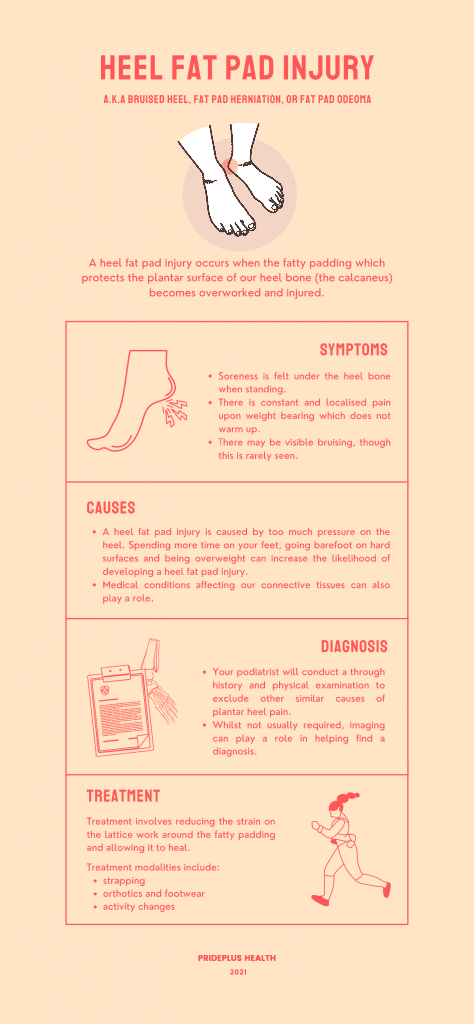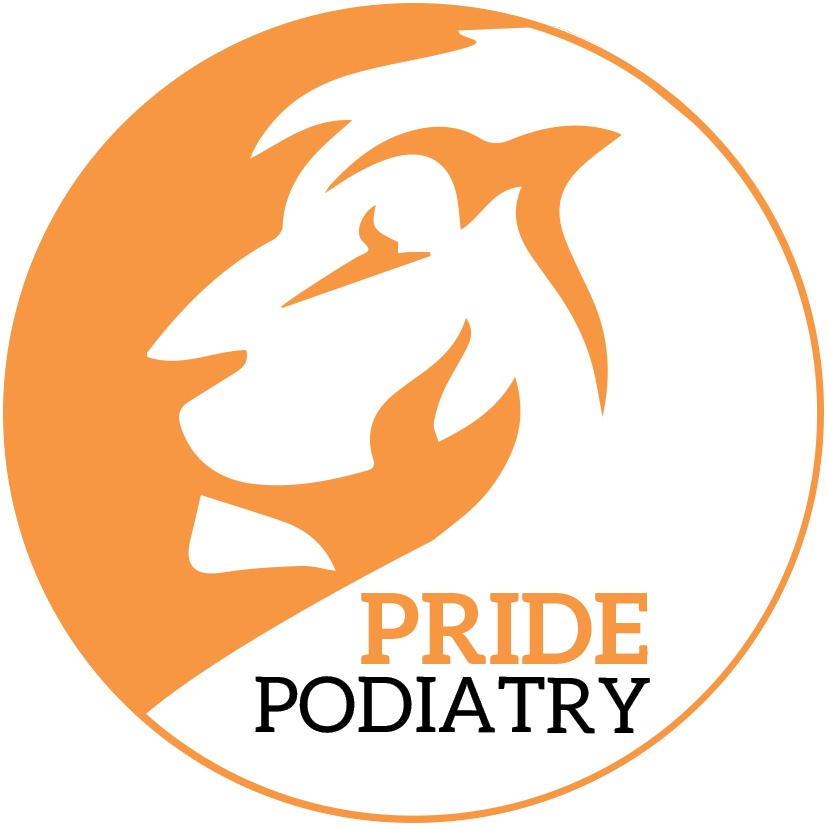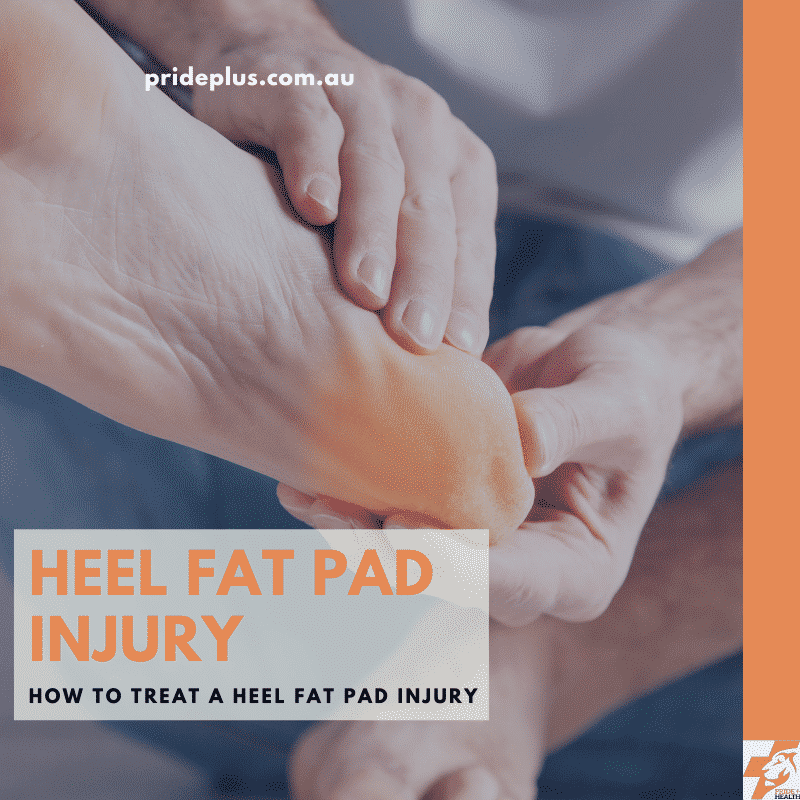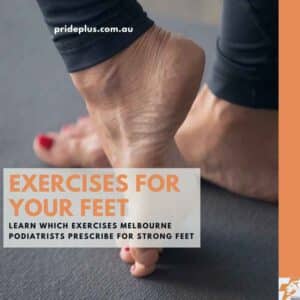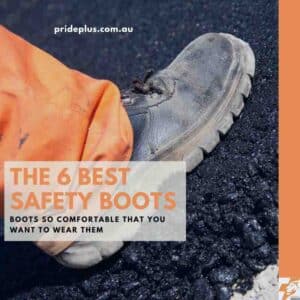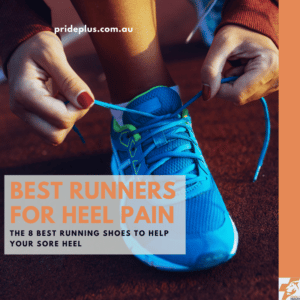If I had to chose what my favourite all time injury to treat in clinic was, it would be a heel fat pad injury. It’s one of the most misunderstood, misdiagnosed and yet rewarding problems to help solve. Let me take you through why.
What is a Heel Fat Pad Injury
A heel fat pad injury is a condition also known as a bruised heel, fat pad herniation or fat pad oedema. Quite simply, it’s where the fatty padding which protects the plantar surface of our heel bone, the calcaneus, and becomes overworked and injured.
While fat pad injuries are reasonably common, they’re often mistaken for the much more prevalent plantar fasciitis. This mistake can lead to plantar heel pain that lasts longer as the treatment for plantar fasciitis and a heel fat pad injury differ.
Here we’ll take you through how repetitive trauma, prolonged periods of standing, and extra pressure can lead to the dreaded bruised heel.
Symptoms of a Heel Fat Pad Injury
A heel fat pad injury will be sore under the heel bone when you’re on your feet. The pain tends to be constant on weight bearing and does not warm up like plantar fasciitis or achilles tendonitis symptoms. Also, your pain is usually very localised, meaning it does not move into the arch of the foot or up the back of the heel.
While also known as a bruised heel, visible bruising on the skin is very rarely seen. This is due to the depth of the trauma where the bleed that is associated with the fat pad injury is deeper than the superficial layers of the skin.
The Causes of a Heel Fat Pad Injury
Too much pressure on the heel is the major cause of a fat pad injury. Often this will happen from a single incident, jumping and landing with force on the heel. Sometimes it can occur with a more insidious onset where the heel fat pad is placed under repetitive strain and an injury occurs. To understand how this happens we need to get into the anatomy of the heel fat pad.
The softer, spongy part of your heel is the fat pad which is very different from the fat that we associate with metabolic conditions, under exercising or in my case, too many Tim-Tams. Across the ball and heel of our feel we have what is known as a loculated fat pad. The best analogy I can use is that you have these bean bag ball like bundles of spongy fat globules which are locked into a tight honeycomb like structure underneath your heel bone.
When we walk and put pressure on our feet these fat balls get squished but stay held together by the fibrous lattice work of “honeycomb” (fascia). We can sometimes see a fat ball or two escape the side of our latticework under our heel and take up residence on the side of our heel bones. These migrated fat globules are known as peizogenic papules.
Back the to actual heel fat pad injury. When the lattice work tears because of over work and strain we get inflammation, pain and bruising present. Spending more time on your feet, going barefoot on hard surfaces, and being overweight can all increase the likelihood of developing a heel fat pad injury.
Other Contributing Factors
Medical conditions which affect our connective tissue also play a role in heel fat pad injury. Fat pad atrophy associated with rheumatoid arthritis, advancing age or long term use of steroids can increase the odds of a heel fat pad injury. These conditions all reduce the elasticity and pliability of our soft tissues which can make them more prone to tear.
How a Heel Fat Pad Injury is Diagnosed
A heel fat pad injury is usually an entirely clinical diagnosis. Your podiatrist will conduct a thorough history and physical examination to exclude other similar causes of plantar heel pain. Often in our clinics we do this as a “2nd opinion” where previously someone is diagnosed with plantar fasciitis which does not respond to plantar fasciitis treatments. In these cases the clinical signs and symptoms as well as a good examination of the heel will likely steer us towards the correct diagnosis.
Whilst not usually required imaging can play a role in helping find a diagnosis. Magnetic resonance imaging as well as ultrasound imaging will both show whether there is a heel fat pad injury present. Another benefit of these imaging modalities is that they will both also show if there are other similar conditions present including the aforementioned plantar fasciitis.
Heel Fat Pad Injury Treatment
To effectively treat a heel fat pad injury we need to reduce the strain on the latticework around the fatty padding and allow it to heal. This will usually be achieved with a combination of specific strapping around the heel, footwear and orthotics, and activity changes.
For the strapping we utilise a couple of techniques (depending on where under the heel the injury is) to hold the heel fat pad tight together and reduce splay.
With shoes and orthotics, much like strapping tape the goal is to reduce the heel fat pad splaying out and putting the injured tissue under strain. Shoes should have a nice, close fitting heel counter to snuggly hold onto you heel.
An orthotic for a heel fat pad injury must also have a heel cup with keeps the heel fat pad from undergoing excessive strain. With the activity changes it will usually involve identifying any triggers such as being barefoot around the house on hard floors or rapid increases in walking, running or jumping. These can either be modified by wearing more appropriate shoes and orthotics to continue these activities or giving them a rest for the time being.
A treatment that we see discussed online for fat pad injuries that really does not have a place as it will not effectively heel a bruised heel is icing. By applying ice to a heel fat pad injury you *may* get a short term reduction in pain however this will not lead to faster healing times. Potentially this short term analgesic effect could allow you to increase your loading again without addressing the causative factors and lead to further tissue damage. Unless you’re already strapping, wearing appropriate shoes and orthotics and changed your activities there’s little reason to ice a bruised heel.
Frequently Asked Questions
What exactly is a heel fat pad?
The heel fat pad is made up of adipose (fat) cells and connective tissues. It’s located between the calcaneus bone and skin under the heel. The main function of the heel fat pad is to cushion the impact when standing on one foot.
Do shoes which advertise lots of cushioning help a bruised heel?
Certainly plush shoes feel better than being barefoot when we have a heel fat pad injury. In some cases a highly cushioned shoe will be excellent for treating an injury to the adipose tissue under the heel. The shoes must also have a snug fitting heel counter as well as being a good shock absorber to be a great treatment option. A soft shoe with good shock absorption but a soft or non-existent heel counter is unlikely to be beneficial.
Bruised Heel Infographic
